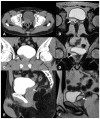Zinner Syndrome-A Rare Cause of Recurrent Epididymitis and Infertility
- PMID: 34940007
- PMCID: PMC8700548
- DOI: 10.3390/clinpract11040108
Zinner Syndrome-A Rare Cause of Recurrent Epididymitis and Infertility
Abstract
Zinner syndrome (ZS) is a rare disorder that affects only men. It is characterized by a triad of abnormalities, including unilateral renal agenesis, ipsilateral seminal vesicle cysts, and atresia of the ejaculatory tract. Unfortunately, there is no consensus on the best treatment modality. We describe a case of a young male patient with recurrent epididymitis, dysuria, and frequent urination. In the diagnostic evaluation, we found an extended right seminal vesicle in the ultrasound with hyperechoic fluid inside and an absence of the right kidney. We performed magnetic resonance imaging, computed tomography, and semen analysis confirming Zinner syndrome and deteriorated semen parameters. Urethroscopic evaluation and ultrasound-guided puncture of the seminal vesicle were performed. An abscess was excluded. The cytologic evaluation showed hemosiderophages. Tamsulosin was introduced. We found no signs of relapse in a six-month observation, and the patient had no further symptoms. Therefore, minimally invasive treatment is a feasible option in young patients found with early-stage Zinner syndrome.
Keywords: Zinner syndrome; epididymitis; infertility; kidney agenesis.
Conflict of interest statement
The authors declare no conflict of interest.
Figures
References
Publication types
LinkOut - more resources
Full Text Sources



